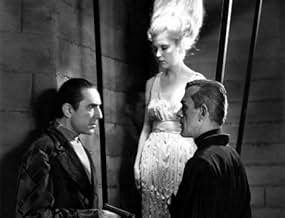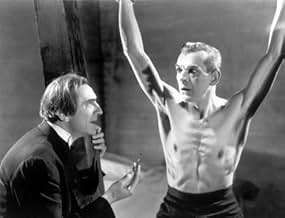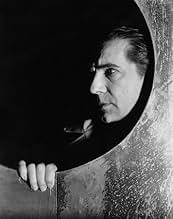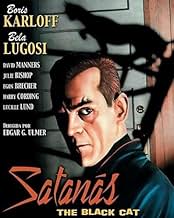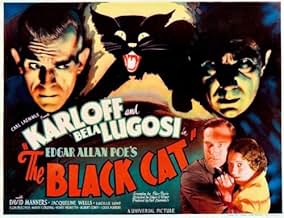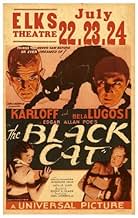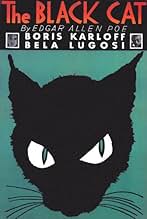IMDb RATING
6.9/10
14K
YOUR RATING
American honeymooners in Hungary become trapped in the home of a Satan-worshipping priest when the bride is taken there for medical help following a road accident.American honeymooners in Hungary become trapped in the home of a Satan-worshipping priest when the bride is taken there for medical help following a road accident.American honeymooners in Hungary become trapped in the home of a Satan-worshipping priest when the bride is taken there for medical help following a road accident.
- Awards
- 2 wins & 1 nomination total
Boris Karloff
- Hjalmar Poelzig
- (as Karloff)
Julie Bishop
- Joan Alison
- (as Jacqueline Wells)
Virginia Ainsworth
- Cultist
- (uncredited)
Luis Alberni
- Train Steward
- (uncredited)
King Baggot
- Cultist
- (uncredited)
Herman Bing
- Car Steward
- (uncredited)
Symona Boniface
- Cultist
- (uncredited)
John Carradine
- Cult Organist
- (uncredited)
André Cheron
- Train Conductor
- (uncredited)
George Davis
- Bus driver
- (uncredited)
Andy Devine
- Bit Part
- (uncredited)
Featured reviews
Travelling across Eastern Europe, Peter and Joan Allison meet Dr Werdegast on the train. When the bus taking them to their destination crashes, the Allisons go with Werdegast and stay with him at the foreboding castle of Hjalmar Poelzig. However the Allisons find themselves in danger when it becomes apparent that Werdegast and Poelzig have a deadly history with each other.
Although it carries the title of his book and a credit for him on the titles, this film has little to do with Poe's work. In fact, in terms of plotting, it owes very little to anybody because, aside from the actual set up, the plot just goes all to hell very quickly. The set up is interesting and I wanted to know more about the history between these two men, then there is the thing about the black cat and Werdegast, not to mention the fact that Poelzig seems to be very interested in reading about satanic cults! However, none of this is really fully explained - this is partly due to the short run time and so much material, but it must also be blamed on the film not having a strong focus other than atmosphere.
The film still works well as the plot crumbles, but it is a little unsatisfying as it leaves so many half stories and unanswered questions. What it does do well though is atmosphere, the direction is cheap but effective and the lighting works wonders in a cheap set! The cast also contribute to this focus on atmosphere (or style) over plot (or substance). Karloff overdoes things, but he overdoes them very well! There is no real need for him to be as ominous as he is at the start but it is what we have come to expect from him. Lugosi may have tarnished his reputation towards the end of his career, but he is good here. It's hard not to laugh when seeing him convulsed with fear over the cat but he plays it well for the most part. Manners and Wells are both OK but are very much the onscreen representation of the audience and simply have to act shocked by everything and run away lots!
Overall this is a good film but only because of the atmosphere and the influence of two legendary stars in the cast. The plot had potential but not enough time is allowed for it to be explored and the focus is more on the atmosphere than the construction.
Although it carries the title of his book and a credit for him on the titles, this film has little to do with Poe's work. In fact, in terms of plotting, it owes very little to anybody because, aside from the actual set up, the plot just goes all to hell very quickly. The set up is interesting and I wanted to know more about the history between these two men, then there is the thing about the black cat and Werdegast, not to mention the fact that Poelzig seems to be very interested in reading about satanic cults! However, none of this is really fully explained - this is partly due to the short run time and so much material, but it must also be blamed on the film not having a strong focus other than atmosphere.
The film still works well as the plot crumbles, but it is a little unsatisfying as it leaves so many half stories and unanswered questions. What it does do well though is atmosphere, the direction is cheap but effective and the lighting works wonders in a cheap set! The cast also contribute to this focus on atmosphere (or style) over plot (or substance). Karloff overdoes things, but he overdoes them very well! There is no real need for him to be as ominous as he is at the start but it is what we have come to expect from him. Lugosi may have tarnished his reputation towards the end of his career, but he is good here. It's hard not to laugh when seeing him convulsed with fear over the cat but he plays it well for the most part. Manners and Wells are both OK but are very much the onscreen representation of the audience and simply have to act shocked by everything and run away lots!
Overall this is a good film but only because of the atmosphere and the influence of two legendary stars in the cast. The plot had potential but not enough time is allowed for it to be explored and the focus is more on the atmosphere than the construction.
Other commentaries will fill you in on the nearly-incomprehensible plot (if that's possible) but, as has been pointed out, you don't watch a film like this for plot.
Despite the story inconsistencies and implausibilities, everything here just seems to "jell:" the fabulous sets, elegant photography, evocative music (drawing heavily from Schubert, among others) and the downright creepy atmosphere woven from the themes of jealousy, lust, revenge, murder, sadism.....all sounds delightfully sick, doesn't it? Truly, it's nowhere near as threatening as it sounds; indeed, if Astaire and Rogers had ever made a spooky thriller, it might have looked and felt something like this one. THE BLACK CAT possesses a lyrical, rhythmic quality, upon which we drift through a sleek, ultra-modern nightmare world.
One of the reasons it all works is its ability to pull us into a sort of parallel universe which, though it looks more or less like reality as we know it, glides along on a barely-concealed undercurrent - an "atmosphere of death," as Lugosi's character puts it - where things happen that "could never actually happen" (an inside reference for those who know the film).
There are some wonderful set-pieces, such as Karloff's tour through a most unusual basement mausoleum/museum memorializing all of his dearly departed earlier "wives." And of course, Boris and Bela deliver, with their restrained but full-bodied performances. Karloff conveys menace just entering a room, and Lugosi has an all-too-rare opportunity to display some tenderness; notice the single tear that rolls down his face as he learns - and sees - what became of the wife that Karloff stole from him years before.
A very stylized - and stylish - film which grants us the unusual treat of seeing Lugosi play a (more or less) "good guy," and the unique one of hearing him pronounce the word "baloney," as only he could.
Despite the story inconsistencies and implausibilities, everything here just seems to "jell:" the fabulous sets, elegant photography, evocative music (drawing heavily from Schubert, among others) and the downright creepy atmosphere woven from the themes of jealousy, lust, revenge, murder, sadism.....all sounds delightfully sick, doesn't it? Truly, it's nowhere near as threatening as it sounds; indeed, if Astaire and Rogers had ever made a spooky thriller, it might have looked and felt something like this one. THE BLACK CAT possesses a lyrical, rhythmic quality, upon which we drift through a sleek, ultra-modern nightmare world.
One of the reasons it all works is its ability to pull us into a sort of parallel universe which, though it looks more or less like reality as we know it, glides along on a barely-concealed undercurrent - an "atmosphere of death," as Lugosi's character puts it - where things happen that "could never actually happen" (an inside reference for those who know the film).
There are some wonderful set-pieces, such as Karloff's tour through a most unusual basement mausoleum/museum memorializing all of his dearly departed earlier "wives." And of course, Boris and Bela deliver, with their restrained but full-bodied performances. Karloff conveys menace just entering a room, and Lugosi has an all-too-rare opportunity to display some tenderness; notice the single tear that rolls down his face as he learns - and sees - what became of the wife that Karloff stole from him years before.
A very stylized - and stylish - film which grants us the unusual treat of seeing Lugosi play a (more or less) "good guy," and the unique one of hearing him pronounce the word "baloney," as only he could.
Made in 1934 by the then 30 year old Director Edgar Ulmer and with the stunning set design by Charles D. Hall the film paired Boris Karloff and Bela Lugosi for the first time together on the screen. This was to cement the two icons together in a screen partnership that would last for several years.
Set in the modern house of Hjalmar Poelzig (no creepy old castle's here) whose home is one of the most stunning modern houses of our time this is a dark story about Devil worship. Poelzig has a room set aside for his evil black masses and has a penchant for the ladies, but only when they are being put to the devil's business. Into this walks a young couple who due to circumstances out of their control end up having to stay the night at his home. They arrive with Dr.Verdegast (Lugosi) who is returning after a absence of many years to settle some unfinished business with his old friend. This is the set up for an explosive encounter between the two into which the young honeymooning couple are thrown.
Truly a masterpiece it should be viewed over and over again.
Watch out for the finale Black Mass in which Karloff spout's authentic sounding incantation's to raise the Devil, he says Latin phrases "Cave Canium" (Beware of the Dog), "In Vito Veritas" (In Wine there if truth) and Cum Grano Salis (with a grain of salt). I could'nt put it better myself.
Set in the modern house of Hjalmar Poelzig (no creepy old castle's here) whose home is one of the most stunning modern houses of our time this is a dark story about Devil worship. Poelzig has a room set aside for his evil black masses and has a penchant for the ladies, but only when they are being put to the devil's business. Into this walks a young couple who due to circumstances out of their control end up having to stay the night at his home. They arrive with Dr.Verdegast (Lugosi) who is returning after a absence of many years to settle some unfinished business with his old friend. This is the set up for an explosive encounter between the two into which the young honeymooning couple are thrown.
Truly a masterpiece it should be viewed over and over again.
Watch out for the finale Black Mass in which Karloff spout's authentic sounding incantation's to raise the Devil, he says Latin phrases "Cave Canium" (Beware of the Dog), "In Vito Veritas" (In Wine there if truth) and Cum Grano Salis (with a grain of salt). I could'nt put it better myself.
There's a lot of story to tell in about 65 minutes, so this movie could be considered perhaps a bit incoherent. But the larger themes -- revenge, lust and innocents caught in the grip of forces beyond their sheltered experience -- have been central themes in horror tales for centuries.
Karloff is a delight as usual, and there are many fine details to his performance -- including a brief but outrageously lustful stare at the half-dressed young wife of the innocent couple and the strangely gentle way his brutal character handles a cat. (Nice tall, dark and handsome kitty in the title role, for the cat people.)
And this movie also shows once again that Bela Lugosi was a better actor than he ever got credit for. He handles his overwrought dialogue with taste and good cheer, and he's a marvel. And he even gets to speak a few rare lines of Hungarian here.
Karloff is a delight as usual, and there are many fine details to his performance -- including a brief but outrageously lustful stare at the half-dressed young wife of the innocent couple and the strangely gentle way his brutal character handles a cat. (Nice tall, dark and handsome kitty in the title role, for the cat people.)
And this movie also shows once again that Bela Lugosi was a better actor than he ever got credit for. He handles his overwrought dialogue with taste and good cheer, and he's a marvel. And he even gets to speak a few rare lines of Hungarian here.
"The Black Cat" (Universal, 1934), directed by Edgar G. Ulmer, marks the first scream, or should I say, screen teaming of Boris ("Frankenstein") Karloff, billed in the credits only as KARLOFF, and Bela ("Dracula") Lugosi.
Suggested on the immortal story by Edgar Allan Poe, the plot, compliments of screenwriter Paul Ruric, set in Hungary, gets right down to business with Doctor Vitus Werdegast (Bela Lugosi) returning home by train after serving 15 long years in a military prison. He finds himself sharing a compartment with mystery writer Peter Allison (David Manners) and his wife, Joan (Jacqueline Wells), on their honeymoon. Vitus introduces himself to the Allisons, talks about himself and of his mission to visit a "very old friend." The couple later accompany Werdegast on a bus to their destination, which meets with an accident during a rainstorm, killing the driver. Vitus accompanies Peter by taking the injured Joan through the rain and winds until they reach the home of Hjalmar Poelzig (KARLOFF), an architect of his futuristic mansion. As Vitus treats the unconscious Joan, Hjalmar, who makes his grand entrance, immediately takes notice on the young girl with intentions that are not too honorable. As the story progresses, the viewer learns that Vitus had been betrayed by Hjalmar during the World War and left to die at a military prison, and for this, Vitus, who survived those long dark years, returns to seek revenge, but first must learn what has happened to his wife and daughter. Peter and Joan become house guests in the home of Poelzig, unaware that they are his prisoners, with Poelzig, who holds Black Masses in a devil's cult ceremony, intending on using Joan as his next subject and hold Peter in a dungeon below. Besides trying to learn the whereabouts of his wife and daughter, Vitus tries to set Joan free by playing a game of chess, or a "game of death," with Hjalmar. Tension builds up to a very suspenseful climax not to be missed.
What does this have to do with a black cat? Well, Vitus fears cats and finds himself being confronted with one in two separate scenes, compliments of Hjalmar, who has cats roaming about. Karloff and Lugosi are evenly matched here, and as bitter enemies, they must present themselves in a "gentlemanly manner" whenever confronted by the young guest or guests. Also presented in the cast are Lucille Lund as Karen Poelzig; the evil looking Harry Cording as Thalmar, Hjalmar's servant; and John Carradine as one of the members of the cult during the Black Mass sequence.
Although produced in Hollywood, "The Black Cat" looks very much like a European production with futuristic sets which features a digital clock, etc. Karloff, dressed in black garments with a feline haircut, is very creepy, especially using gestures with his evil eyes (which do everything but glow in the dark!); Lugosi, in a rare sympathetic role, is actually the stronger character, giving one of his best performances in his career, next to "Dracula" (1931). Fortunately, "The Black Cat" was released shortly before the Production Code took effect, otherwise the horror drama, with many scenes quite questionable then and now, would never have reached the theaters unless severely edited to a point of confusion. Chances are the movie itself was edited prior to release, but at 66 minutes, it's tight and fast-paced, never a dull moment. A big plus in this production is the underscoring montage of classical compositions by various composers, lavish sets and the teaming of two horror greats, Karloff and Lugosi.
Aside from Fright Nights on commercial television back in the 1960s and 70s, "The Black Cat" formerly played on the Sci-Fi Channel in the 1990s, and later on American Movie Classics from 2000 to 2001. To date, "The Black Cat" can be seen on Turner Classic Movies where it premiered on January 24, 2003, becoming one of this cable channel's most revived horror films. Probably by request. "The Black Cat" is also available on video cassette either as part of the double feature along with "The Raven" (1935), another Karloff and Lugosi thriller, or as a solo package. A gem for fans of this genre. (***)
Suggested on the immortal story by Edgar Allan Poe, the plot, compliments of screenwriter Paul Ruric, set in Hungary, gets right down to business with Doctor Vitus Werdegast (Bela Lugosi) returning home by train after serving 15 long years in a military prison. He finds himself sharing a compartment with mystery writer Peter Allison (David Manners) and his wife, Joan (Jacqueline Wells), on their honeymoon. Vitus introduces himself to the Allisons, talks about himself and of his mission to visit a "very old friend." The couple later accompany Werdegast on a bus to their destination, which meets with an accident during a rainstorm, killing the driver. Vitus accompanies Peter by taking the injured Joan through the rain and winds until they reach the home of Hjalmar Poelzig (KARLOFF), an architect of his futuristic mansion. As Vitus treats the unconscious Joan, Hjalmar, who makes his grand entrance, immediately takes notice on the young girl with intentions that are not too honorable. As the story progresses, the viewer learns that Vitus had been betrayed by Hjalmar during the World War and left to die at a military prison, and for this, Vitus, who survived those long dark years, returns to seek revenge, but first must learn what has happened to his wife and daughter. Peter and Joan become house guests in the home of Poelzig, unaware that they are his prisoners, with Poelzig, who holds Black Masses in a devil's cult ceremony, intending on using Joan as his next subject and hold Peter in a dungeon below. Besides trying to learn the whereabouts of his wife and daughter, Vitus tries to set Joan free by playing a game of chess, or a "game of death," with Hjalmar. Tension builds up to a very suspenseful climax not to be missed.
What does this have to do with a black cat? Well, Vitus fears cats and finds himself being confronted with one in two separate scenes, compliments of Hjalmar, who has cats roaming about. Karloff and Lugosi are evenly matched here, and as bitter enemies, they must present themselves in a "gentlemanly manner" whenever confronted by the young guest or guests. Also presented in the cast are Lucille Lund as Karen Poelzig; the evil looking Harry Cording as Thalmar, Hjalmar's servant; and John Carradine as one of the members of the cult during the Black Mass sequence.
Although produced in Hollywood, "The Black Cat" looks very much like a European production with futuristic sets which features a digital clock, etc. Karloff, dressed in black garments with a feline haircut, is very creepy, especially using gestures with his evil eyes (which do everything but glow in the dark!); Lugosi, in a rare sympathetic role, is actually the stronger character, giving one of his best performances in his career, next to "Dracula" (1931). Fortunately, "The Black Cat" was released shortly before the Production Code took effect, otherwise the horror drama, with many scenes quite questionable then and now, would never have reached the theaters unless severely edited to a point of confusion. Chances are the movie itself was edited prior to release, but at 66 minutes, it's tight and fast-paced, never a dull moment. A big plus in this production is the underscoring montage of classical compositions by various composers, lavish sets and the teaming of two horror greats, Karloff and Lugosi.
Aside from Fright Nights on commercial television back in the 1960s and 70s, "The Black Cat" formerly played on the Sci-Fi Channel in the 1990s, and later on American Movie Classics from 2000 to 2001. To date, "The Black Cat" can be seen on Turner Classic Movies where it premiered on January 24, 2003, becoming one of this cable channel's most revived horror films. Probably by request. "The Black Cat" is also available on video cassette either as part of the double feature along with "The Raven" (1935), another Karloff and Lugosi thriller, or as a solo package. A gem for fans of this genre. (***)
Did you know
- TriviaAmong the unconventional elements of this film was the soundtrack. At a time (early 1930s) when movie music was usually limited to the titles and credits, Edgar G. Ulmer had an almost continuous background score throughout the entire film.
- GoofsVitus identifies Kurgaal as being "near Omsk, by Lake Baikal." In reality Omsk and Lake Baikal are approximately 1000 miles apart and are nowhere near each other.
- Quotes
Hjalmar Poelzig: Did you hear that, Vitus? The phone is dead. Even the phone is dead.
- ConnectionsEdited from Rome Express (1932)
Details
Box office
- Budget
- $95,745 (estimated)
- Gross worldwide
- $180
- Runtime1 hour 5 minutes
- Color
- Aspect ratio
- 1.37 : 1
Contribute to this page
Suggest an edit or add missing content



